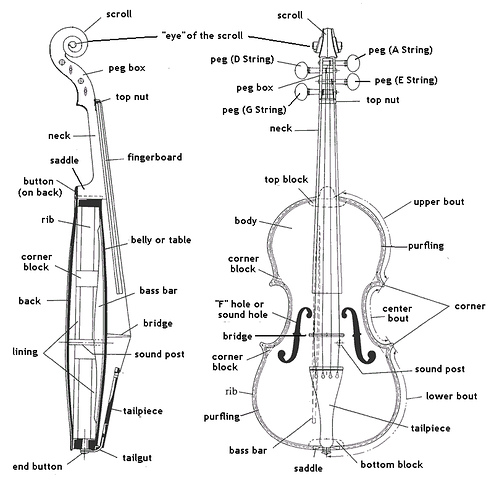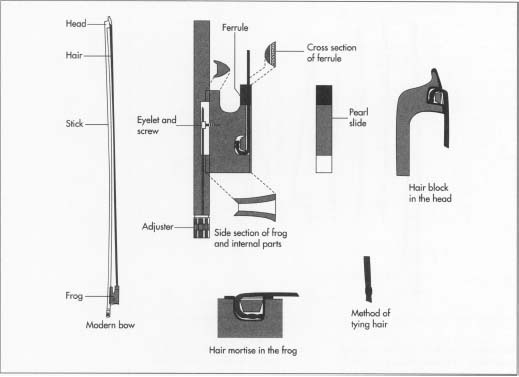|
|
The bridge of a violin has two purposes. First, it holds the strings in a laterally arched configuration, allowing each to be touched separately by the bow. The bridge also transmits the sound vibrations to the belly, from which they are transmitted to the back by the sound post, which is fitted below the bridge. Usually the belly, the sound post, and the bass bar are made of spruce, a light but strong softwood. The back, ribs, neck, peg-box, scroll, and bridge are of maple, a hardwood. The fingerboard is made of ebony, but some old violins have ivory fingerboards. Strings were originally gut, and gut is still often used in historically accurate performances of music from the 18th century and earlier. However, they have a tendency to go out of tune and snap more easily than modern strings, which are made from metal. Modern A, D and G strings are usually metal-cored and wound with metal for greater mass in order to vibrate at a lower pitch, with the E (top) string being a metal mono-filament of steel. Synthetic cored strings (wound with metal) are also employed today; they combine some of the benefits of gut strings with greater longevity and tuning stability. |
|
|
The best modern bows used to play orchestral string instruments
of the violin family are usually made of Pernambuco, a wood from Brazil
and are strung with horse-hair.
Silver or gold, ebony from Africa, ivory, pearl shell, leather, and sometimes tortoise shell are materials commonly used for the "frog" and finger grip. Some fine synthetic bows are also made of fiberglass and other man made materials. Cheaper bows can be made of synthetic materials and less suitable types of wood. A bow maker or luthier typically uses 150 hairs for the bows for violin family instruments. Inexpensive bows often use nylon or synthetic hair. Rosin, which is sticky and made from tree sap, is regularly applied to the bow hair so that when the bow moves across the instrument's strings it causes the string to vibrate and produce a tone. The kind of bow in use today was brought into its modern form largely by the bow-maker François Tourte in 19th century France. Pernambuco wood which was imported into France to make textile dye, was found by the early French bow masters to have just the right combination of strength, resiliency, weight, and beauty.
|
|
|
Detail of the head and frog of a bow. |
|
|
As the bridge transmits the vibrations to the body of the
instrument for amplitication, its role is crucial. There is a right and
a wrong way round fro violin bridges, notably with the treble side being
lower.
The E string slot may also have a small piece of bone inset, to prevent the fine string cutting down into the bridge itself. |


